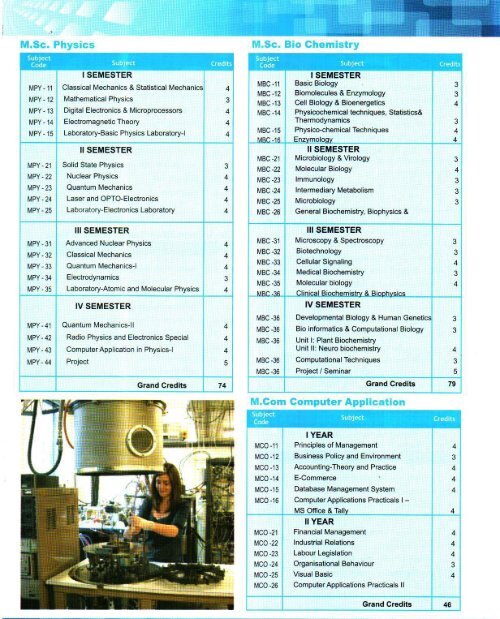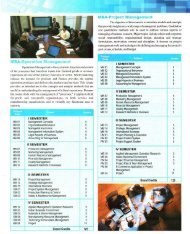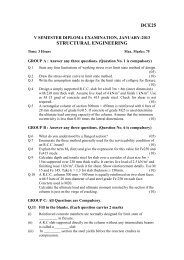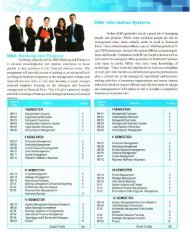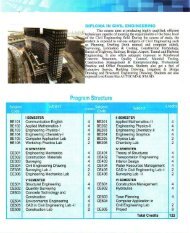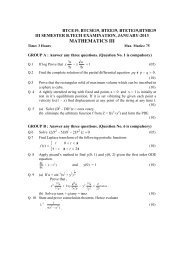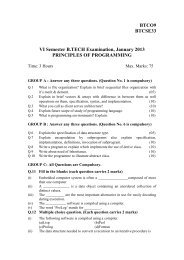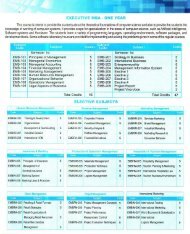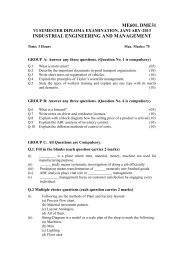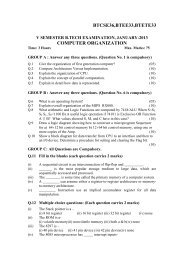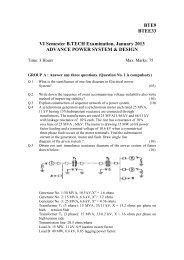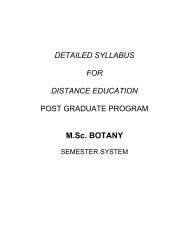M.Sc Physics - Skymount Distance Education
M.Sc Physics - Skymount Distance Education
M.Sc Physics - Skymount Distance Education
Create successful ePaper yourself
Turn your PDF publications into a flip-book with our unique Google optimized e-Paper software.
KARANATAKA STATE OPEN UNIVERSITYM.SC PHYSICSSYLLABUS
Syllabus & Regulations Governing ‘M.SC PHYSICS1. Title of the Program: M.SC PHYSICS2. Duration of the Program: 2 Year3. Nature of the Program: Semester System4. Eligibility Conditions: B.<strong>Sc</strong> (PHYSICS)5. Allocation of Credits – Total -74- Credits6. Evaluation System :The distribution of marks for evaluation in each subject shall be asfollows –Theory Subjects :Internal assessment 20marksTerm End University Examination 80marksPracticals :Internal assessment ( for each practical) 20marksTerm End University Examination 80marksProject :Internal Assessment 50marksUniversity Examination 150marksMinimum for pass :32 marks per course in theory and aggregate 40% includingassessmentCourse exemption : 40% marks and above in each course7. Academic Structure
SubjectCode1.1Course TitleClassical Mechanics andStatistical MechanicsCredits Marks4 20 80 100I SEMESTERII SEMESTER III SEMESTER IV SEMESTER1.2 Mathematical <strong>Physics</strong> 3 20 80 1001.3Digital Electronics &Microprocessors4 20 80 1001.4 Electromagnetic Theory 4 20 80 1001.5Laboratory-Basic <strong>Physics</strong>Laboratory-I4 20 80 1002.1 Solid State <strong>Physics</strong> 3 20 80 1002.2 Nuclear <strong>Physics</strong> 4 20 80 1002.3 Quantum Mechanics 4 20 80 1002.4 Laser and OPTO-Electronics 4 20 80 1002.5 Laboratory-ElectronicsLaboratory4 20 80 1003.1 Advanced Nuclear <strong>Physics</strong> 4 20 80 1003.2 Classical Mechanics 4 20 80 1003.3 Quantum Mechanics-I 4 20 80 1003.4 Electrodynamics 3 20 80 1003.5Laboratory-Atomic andMolecular <strong>Physics</strong>4 20 80 1004.1 Quantum Mechanics-II 4 20 80 1004.24.3Radio <strong>Physics</strong> and ElectronicsSpecialComputer Application in<strong>Physics</strong>-I4 20 80 1004 20 80 1004.4Project 5 50 150 200
I Year-I SemesterM.SC. PHYSICSI YAERSUBJECT CODE: 1.1SUBJECT: CLASSICAL MECHANICS AND STATISTICAL MECHANICSUNIT INewtonian mechanics of single and many body systems - conservation laws-work energy theorem -constraints - De'Alembert's principle and Lagrangianequation -application of Lagrangian equation to simple pendulum andAtwood's machine - varia-tional principle - derivation of Lagrangian equationfrom Hamilton's principle.UNIT IIHamilton's equation from variational principle - principle of least action -canonical transformation generating function - group properties - Poisson'sbracket and theorem - angular momentum Poission bracket - Hamilton -Jacobi equation - Hamilton's principle functions - application to harmonicoscillator.UNIT IIIRigid body motion - spinning top motion - independent coordinate of rigidbodies - orthogonal transformation - central force problem -definitions andcharacteristics - equation of motion and first integrals - Kepler's problems -inverse square law of forces - motion in time in Kepler's problem - scatteringin a central force field.UNIT IVContact between statistical and thermodynamics of the system - classicalideal gas - Gibb's paradox - micro canonical ensemble - phase space -trajectory and density of states - canonical and grand canonical ensembles -micro and macro states - Sterling’s formula - most probable distributions jM-B distrjpution - law of equipartition of energy.
UNIT VBose - Einstein statistics - black body radiation arid photon statistics -specific heat of solids - Dulong and Petits law f Einstein's theory of specificheat - Debye's theory of specific heat - BE condensation - Fermi-Diracstatistics- equation of states of ideal gas - high temperature and low density- low temperature and high density - theory of electron gas - statistics ofoccupation number - calculation of thermodynamic quantities.REFERENCE BOOKS:1. Classical Mechanics - N.C. Rana and P.S. Joag (Tata McGraw-Hill,1991)2. Classical Mechanics - H. Goldstein (Addition Wesley, 1980)3. Principles of Mechanics - Synge and Griffith '4. Introduction to Classical Mechanics - R.G. Takwale and P.S. Puranik5. Thermodynamics Searls and Salinger6. Statistical Mechanics - Kerson and K. Huang7. Statistical Mechanics-R.K. Pathria8. Statistical Mechanics - Sears and zymanski9.Statistical <strong>Physics</strong> - A.K. Agarwal and Melvin Eisner
SUBJECT CODE: 1.2SUBJECT: MATHEMATICAL PHYSICSUNIT IVector spaces matrices and tensors - linear independence - inner product-<strong>Sc</strong>hwartz inequality - matrix representation of vector and linear operatorswith respect to basis - change of basis - <strong>Sc</strong>hmidt orthogonalization -matrices - unitary - Hermitian sym- metric matrices - orthogonal matrices -inverse of a matrix-matrix multiplication-rotation matrices - eigen valuesand eigen vectors - concept of orthogonal sets of functions - tensors - basicideas of contravariant- covariant and mixed tensors.UNIT IIPower series solution - power series solution of – Legendre – Hermite – LeLageurre - Hermite polynomials – recurrence relations – generatingfunctions-orthogoMlity conditions.UNIT IIIPartial differential equations - separation of variables - heat conductionproblem - variable linear flow two and three dimensional heat flow –temperature inside circular and rectangular plates - cooling of hot brick -electrical analogy of heat flow – current density and total current in a wire -skin effect - vibration of streched string and membrene.UNIT IVComplex variables - function of a complex variable - analytical function -Cauchy-Rheinman equation - Cauchy 's integral theorem and formula -Tayor's and Laurent's expansion - residue theorem and application -conformal mapping - basic concepts - mapping by w = az + b and w ==exp(z).UNIT VProbability and statistics – discrete probability distribution - combinations
and permutations - Stirling's approximation for factorials of large numberscontinuousdistribution - binominal distribution – Poisson’s distribution -normal distribution-curve fitting - least square analysis.REFERANCE BOOKS:1. Matrices and Tensors - Jdslji2. Vector and Tensors – Spiegel – <strong>Sc</strong>haum Series3. Applied Mathematics for Physicists and Engineers – Pipes an Harwill4. Complex variables – Spiegel – <strong>Sc</strong>haum Series5. Mathematical <strong>Physics</strong> - Eugine Butkov.
SUBJECT CODE: 1.3SUBJECT: DIGITAL ELECTRONICS AND MICROPROCESSORSUNIT 1Logic gates - block diagram - truth table- Ex OR gate - equivalent functions -combinational logic - half adder / subtract or - full adder / subtracted - DeMorgan's laws-Boolean algebra - Karnaugh maps - max and min terms -encoders and decoders - multiplexers and demultiplexers.UNIT IISequential logic – flip – flops – sequential circuit analysis – state diagram –state equation – registers – counters – up – down counters – timiningsequenes – the memory unit – Random Access Memory (RAM) – Magneticcore memory.UNIT IIICommon microprocessor characteristic - pin diagram and functions forgeneric microprocessor - microprocessor architecture - the intel 8085microprocessor - the 8085 pin diagram and functions - 8085 architecture -different addressiag modes - 8085 instruction set - arithmetic, logical andbranch instructions - the 8085 stack, I/O and control instructions.UNIT IVProgramming the 8085 microprocessor - 8 bit addition, subtraction,multiplication and division - looping programs - sum of data - maximum,minimum values of the given array - ascending / descendmg - data transfer-16 bit addition – relay generation – multiple precision arithmetic - decimalarithmetic - subroutine programs - ASCII to decimal multiple precisionaddition subroutine.UNIT VTimining diagram - instruction cycle, machine cycle, R/W cycle - minterfacing the microprocessor - interfacing with ROM - interfacing withRAM - I/O interfacing basics.
SUBJECT CODE: 1.4SUBJECT: ELECTROMAGNETIC THEORYUNIT IElectrostatics – Field and potential due to a point charge - line charge –surface charge and volume charge – divergence and curl of electrostaticfield – energy due to point charge distribution and continuous chargedistribution – Poisson equation and Laplace equation – electrostaticboundary condition – separation of variables – Cartesian and sphericalcoordinates – multipole and dipole – problems in dipole interaction –electrostatic fields in matter – dielectrics – dipoles induced in polarisability –polarisability tensor – electric field produced by uniform polarized sphere –field inside dielectric – Gauss law with dielectric – susceptibility –permeability and dielectric constant – susceptibility tensor field inside alinear dielectric sphere when placed in a electric field – force on a chargeoutside a linear dielectric slab – energy in a dielectric system – forces ondielectrics – connection between polarisability and susceptibility.UNIT IIMagnetostatics - Lorentz force - cyclotron motion - continuity equation - Blotand Savart’s law for line, surface and volume currents - divergence and curlof B - Ampere's law – applications - magnetic vector potential - multipleexpansion of vector potential - Dia, Para and ferromagnet torques and forceson magnetic dipoles - magnetic field of a uniformly magnetized sphere -magnetic susceptibility and permeability in linear media and non linearmedia - ferromagnetism.UNIT IIIOhm's law - Faraday's law - electromagnetic inductance - energy inmagnetic field Maxwell's equations - boundary conditions - scalar. andvector potentials – gauge transformation – Coulomb gauge and Lorentzgauge – energy arid momentum in electrodynamics - Maxwell's stresstensor – conservation of momentum.
UNIT IVElectromagnetic waves - the wave equation - oolarization - reflection andtransmission - boundary conditions - electromagnetic waves In nonconducting media - propagation through linear media - reflection andtransmission at normal incidence and oblique incidence - electromagneticwaves in conductors - reflection and transmission at conducing surface -plasma wave guides -T£ waves in rectangular wave guides - coaxialtransmission line.UNIT VElectromagnetic radiation - retarded potential and potential - electric andmagnetic dipole radiation - radiation from point charge – fields of a pointcharge Bremsstrauhlung, Synchrotron radiation and Cerenkov radiation.REFERENCE BOOKS:1. Classical Electrodyhamics - J.D. Jackson.2. Foundation of electromagnetic theory - Rietz, Milford and Griffith.3. Electromagnetic fields and waves - P. Lorrain and D. Corson.
SUBJECT CODE: 1.5Basic <strong>Physics</strong> Laboratory – I(Any 10 Experiment)1. Michelson Interferometer.2. Resistivity of Ge at various temperature by Four Probe method anddetermination ofband gap.3. Susceptibility, Gauy method.4. Ionic Conductivity of NaCl.5. Skin depth in Al using electromagnetic radiation.6. Counting statistics, G.M. tube.7. End point energy and Absorption coefficient using G.M.tube.8. Conductivity of Plasma at various pressure for AC/DC source.9. Electron Spin Resonance. (ESR)10. Fabry-Parot Etalon.11. Electron Diffraction.12. Thermionic Emission.13. Franck – Hertz Experiment.14. Zeeman Effect.15. ‘e’ by Millikan oil drop method.16. Stefan’s constant – Black body radiation.17. Clausius – Mossotti equation using sugar solution ( Determination ofPolarisation.)18. To study absorption spectra of Iodine molecule and to determine itsdissociation energyusing spectrometer.19. Comparison of resolving limit of optical instruments with human eye.(Pg. 300-301,A world view of <strong>Physics</strong> by Prof. D.P. Khandelwal et al. South AsianPublishers pvt. Ltd.New Delhi, 1999)20. Study of electromagnetic damping ( Pg. 320, A world view of <strong>Physics</strong> byProf. D.P.
Khandelwal et al. South Asian Publishers pvt. Ltd.New Delhi, 1999)Reference Books :1. Solid State Laboratory Manual in <strong>Physics</strong>, Department of <strong>Physics</strong>,University of Pune,Pune-7. (1977)2. Experimental <strong>Physics</strong>, Wersnop and Flint.3. Molecular structure and Spectroscopy, G.Aruldas Prentice-hall of IndiaPvt. Ltd. New Delhi.4. Solid State <strong>Physics</strong>, S.P. Pillai (3rd Edition), New age InternationalPublisher.5. Practical <strong>Physics</strong>, D.R. Behekar, Dr.S. T. Seman, V.M.Gokhale,P.G.Kale( Kitab Mahal Publication)6. Introduction to experimental Nuclear <strong>Physics</strong>, R.M. Singru, Wiley Easternprivate Ltd.New Delhi.
SUBJECT CODE: 2.1SUBJECT: SOLID STATE PHYSICSUNIT ICrystal lattices.- two and three dimensional lattice types - simple crystalstructure - reciprocal lattice - Brillouin sones - structure factor of the basis -atomic scattering factor - cohesive energy - compressibility and bulkmodulus - dielectric and ferroelectric properties of crystals - local electricfield at an atom - Lorentz field - different types of polarisation - complexdielectric constants - Clausius-Mosetti relation.UNIT II:Phonons and lattice vibrations - quantisation of lattice vibrations -vibrations of monoatomic lattices - lattice with two atoms per primitive cell -lattice heat capacity - Einstein and Debye's models - density of states - anharmonic crystal - their interactions Tlattice thermal conductivity -Umplkapp process.UNIT III:Energy bands - nearly free electron model - Bloch function - Kroneig - Pennymodel -wave equation of electrons in a periodic potential - number oforbitals in a band - effective mass -classification of solids - free electron gas- heat capacity of electron gas - motion in magnetic fields -Hall effect.UNIT IV:Magnetism - Langevin's theory of paramagnetism – quantum theory ofparamagnetism – Hund’s rules – paramagnetic susceptibility of conductionelectrons – Weiss theory of ferromagnetism – ferromagnetic order – Curiepoint – spin waves – quantization of spin waves – magnons – ferri, antiferriand antiferro magnetism.UNIT V:Superconductivity - Meissner effect - heat capacity- energy gap - isotopic
effect - thermodynamics of the superconducting transitions - Londonequations – BCS theory - Type I and type II super-conductors.REFERENCE BOOKS:1. Introduction to Solids -LV.Azaroff2. Introduction to Solid State <strong>Physics</strong> - Charles Kittel V edition3. Elementary Solid State <strong>Physics</strong> - Ali Omar4. Solid State <strong>Physics</strong>- AJ. Dekkar
SUBJECT CODE: 2.2SUBJECT: NUCLEAR PHYSICSUNIT IElementary Particles: Classification of elementary particles and types ofinteraction of elementary particles - Leptons - Hadrons - Mesons - Hyperons- strange particles -conservation laws - CPT theorem - Quark model -Gellmann-Okubo mass formula - SU3 multiplet - Baryon octet and baryondecouplet - Mesons nonet- elementary idea of Gauge bosons.UNIT IINuclear decay: Gamow’s theory of alpha decay – Dermi’s theory of betadecay – Curie plot – shape of beta ray spectrum – parity violation in betadecay – Fermi and Gamow Teller selection rules – multipole radiation –selection rules – internal conversion – nuclear isomerism.UNIT 111Nuclear models: Liquid drop model, Bohr - Wheeler theory of fission -evidence for shell effect - shell model - spin - orbit coupling - angularmomentum and parity of nuclear ground states - magnetic moment and<strong>Sc</strong>hmidt lines - collective model of Bohr.UNIT IVGround state of deuteron - excited states - magnetic moment andquadrupole moment of deuteron - n-p scattering and p-p scattering -effective range theory - meson theory of nuclear force - Compound nucleartheory - Reciprocity theorem - Resonance scattering - Breit-Wigner one levelformula.UNIT VNeutron sources - classification of neutrons - energy distribution of thermalneutrons - neutron diffusion - current density - leakage rate – thermalneutron diffusion - fast neutron diffusion - Fermi age equation - nuclear
chain reaction - four factor formula - critical size of a reactor -classificationof reactors - thermal reactors - power reactor research reaction - breederreaction.REFERENCE BOOKS1. Nuclear <strong>Physics</strong> - D.C. Tayal2. Elements of Nuclear <strong>Physics</strong>, - M.L. Pafi|dya and PJ.P.S. Yadav3. Nuclear <strong>Physics</strong> - Irwin Kaplan4. Introduction to Nuclear <strong>Physics</strong> – Herald Enge5. Nuclear <strong>Physics</strong> - Roy and Nigam6. Nuclear <strong>Physics</strong> - Cohen
SUBJECT CODE: 2.3SUBJECT: QUANTUM MECHANICSUNIT I<strong>Sc</strong>hrodinger equation - free particle in one dimension - Generalization tothree dimension - Shrodinger equation for a particle subjected to a force -continuity equation - normalization - probability interpretation.-conservation of probability - Ehrenfast theorem - time independentShrodinger equation - particle in a square well potential - bound states in asquare well E 0 - Adjoint and self adjontoperators - eigenvalue problem - degeneracy - eigenvalues andeigenfunctions of self adjoint operators^ uncertainty principle - proofcommutation relations.UNIT IIAngular momentum in quantum mechanic - central force problems -addition of angular momenta - exactly solvable eigenvalue problems - thesimple harmonic oscillator - Hydrogenatom - Rigid rotator - schrodinger,Heisenberg and interaction pictures - matrix theory of harmonic oscillator -Raising and lowering operators.UNIT IIIStationary perturbation theory -1 arid II order perturbation of oscillator -Zeeman effect without electron spin - variation method - ground state ofhelium - WKB approximation - Time dependent perturbation theory - FermiGolden rule.UNIT IV<strong>Sc</strong>attering theory - kinematics of scattering process - scattering amplitudesand scattering cross section - partial wave analysis from simple potentials -phase shift - scattering amplitude in terms of phase - Optical theorem -Born approximation - <strong>Sc</strong>attering by a perfectly rigid system - square well,coulomb arid Yukawa potentials.
UNIT VSemiclassical theory of radiation –Einstein’s coefficients for spontaneousand stimulated emission of radiation - relations between them – transitionprobability for absorption and induced emission - Klein Gordon equation -difficulties – Dirac equation – Dirac matrices and their properties - Freeparticle solution of Dirac equation - negative energy states – positrons – spinangular momentum and magnetic moment of election in a magnetic field.REFERENCE BOOKS:1. Quantum Mechanics - Matthews and Venkatesan.2. Quantum Mechanics-L.L <strong>Sc</strong>hiff.3. Quantum Mechanics - Satyaprakash.4. Quantum Mechanics - Lee.5. Quaritum Mechanics - A.P.Messiall
SUBJECT CODE: 2.4SUBJECT: LASER AND OPTO - ELECTRONICSUNIT ILightwave fundamentals - electro-magnetic waves - dispersion -pulsedistortion - information rate - polarization - resonant cavities - reflectionat a plane boundaries - critical angle - reflections.UNIT IIIntegrated optic wave guides - dielectric slab wave guide - modes in thesymmetric slab wave guide -modes in the asymmetric slab wave guide -coupling to the wave guide - integrated optic networks - optic fibre waveguides - step index fibre - graded index fibre - attenuation - modes instep index fibre and graded index fibre - pulse distortion - informationrate - optic fibre cables.UNIT IIILight soured and detectors – LED’s – characteristics – LASER principles –ruby LASER – Nd YAG LASER, Neodymium glass LASER, He-Ne LASERCO2 LASER, LASER diodes, operating characteristics, light detectors,principles of photo detection, PMT, PIN photo diode, avalanche photodiode, CCD.UNIT IVCouples and connectors -connector principles - fibre end preparation,splices, connectors, source coupling, modulation, LED modulation andcircuits, analog modulation formats, digital modulation formats, opticheterodyne receivers, holography.UNIT VHarmonic generation - 2nd and 3rd harmonic generation - phasematching - optical mixing - parametric generation of light - cell focussingof light
REFERENCE BOOKS:1. Fibre optic communications - Joseph & Palaias2. LASERS and non-linear optics -B.B.Laud
SUBJECT CODE: 2.5Electronics Laboratory(Any 10 Experiment)1. Study of voltage controlled oscillator using IC-566.2. Frequency multiplier using PLL-565(for 2 & 3 operation usingcounter.)3. Fold back power supply.4. Precision rectifier.5. Crystal oscillator- Millar type and Digital clock.6. Diode pump using UJT.7. DAC (R-2R and Binary type for 4-bit).8. Pulse train generator.9. SMPS power supply.10. CVCC power supply.11. Active filter- Low pass, High pass, Band pass, and Notch Filter usingOP-AMP.12. Function generator using OP-AMP/IC –8038.13. Study of optocoupler, MCT2E and their application.14. Constant current source using OP-AMP.15. Class-B push pull amplifier using Dual power supply and OP-AMP.16. Design, built and test oscillator – Wien Bridge oscillator / phase shiftoscillator usingOP-AMP.17.Inductive simulation using OP-AMP.18. tudy of multiplexer and Demultiplexer.19. Voltage to Frequency / Frequency to voltage converter using OP-AMP.20. Study of errors in electrical measurement and results due to loading.21. Fourier analysis (Pg. 18, Experiments in Electronics, S.V.Subramaniam, McMillan IndiaLimited, 1982)
22. To determine the transition capacitance of a varactor diode and use itas a variablecapacitor.(Pg. 28, Experiments in Electronics, S.V. Subramaniam,Mcmillan IndiaLimited, 1982)23. Measurement of efficiency of a power amplifier.(IC 810)and study ofits frequencyresponse.(Pg. 118, Experiments in Electronics, S.V. Subramaniam,Mcmillan IndiaLimited, 1982)24.Study of noise performance of an amplifier.(Pg. 449, Art ofElectronics, Horowitz and Hill,Cambridge, University Press, Low Price Edition, 1995.)Reference Books :1.Signetic manual.2. Power supplied, B.S.Sonde.3. Digital Principles, Malvino ( 6th Edition, Tata McGraw Hill PublicationCo. Ltd. Delhi.)4. Operational Amplifier , G.B.Clayton.5. OP-AMPS and Linear integrated circuits, Ramakant Gaikwad.6.Data Converters, B.S. Sonde, Tata Mc-Graw Hill Pub. Co. Ltd. (1974).7. Pulse, Digital and Switching Circuits, Miliman & Taub.8. Electronic Integrated Circuits and Systems, Franklin, C. Fitchen( VanNo strandReinhold Company).9. Digital Principles and applications, Leach and Malvino, Tata Mc-GrawHill Pub.Co.Ltd. N.Delhi(5th Edition,2002).
II YEARSUBJECT CODE: 3.1SUBJECT: ADVANCED NUCLEAR PHYSICSUNIT IAddition of angular momentum – Clebsch – Gordan coefficients –symmetry properties – evaluation of Clebsch – Gordan coefficients insimple cases – rotational matrices forspinors – spherical tensors –rotation matrices – Wigner – Eckart theorem – simple applications.UNIT IINilsson model – collective model of Bohr – Mottelson – rotation andvibration – residual interaction – 0.18 energy level calculations – twocentre shell model.UNIT IIIStrutinsky’s prescription – shell effect – potential energy surfaces –nuclear moment of inertia – cranking model – pairing correlation innuclei – BCS theory.UNIT IVNuclear stress – backbending – high spin states – hot nuclei – statisticaltheory – nuclear level density – thermal fluctuations – giant dipoleresonance.UNIT VCharactertistics of accelerators – beam modulation – column structure –electrostatic accelerators – Van de Graff accelerator – tandem principle –pelletron – AVF cyclotron – principles of phase shift.REFERENCE BOOKS:1. Nuclear <strong>Physics</strong> – Roy and Nigam
2. Introduction to Nuclear <strong>Physics</strong> – Herald Enge3. Nuclear <strong>Physics</strong> – D.C.Tayal4. Nuclear <strong>Physics</strong> – S.B.Patel5. Nuclear <strong>Physics</strong> – Irwin Kaplan
SUBJECT CODE: 3.2SUBJECT: CLASSICAL MECHANICS1 Constrained MotionConstraints, Classification of Constraints, Principal of Virtual Work,D’Alembert’sprincipal and its applications (Problems only), (One or Two Problemsshould be discussedwith D’Alembert’s, Lagrangian, Hamiltons from same set of problems).(2L+2P).2 Lagrangian formulationGeneralized coordinates, Langrange’s equations of motion, properties ofkineticenergy function, theorem on total energy, generalized momenta, cycliccoordinates,integralsof motion, Jacobi integrals and energy conservation, Concept ofsymmetry, invariance underGalilean transformation, velocity dependent potential. (6L+5P)3 Hamilton’s formulationHamilton’s function and Hamilton’s equation of motion, configurationspace, phasespace and state space, Lagrangian and Hamiltonian of relativisticparticles and light rays.(3L+4P)4 Variational PrincipleVariational principle, Euler’s equation, applications of variationalprinciple, shortestdistance problem, brachistrochrone, Geodesics of a Sphere. (3L+2P)5 Canonical TransformationsGenerating function, Conditions for canonical transformation andproblem. (3L+2P)
6 Poisson BracketsDefinition, Identities, Poisson theorem, Jacobi-Poisson theorem, Jacobiidentity,(statement only), invariance of PB under canonical transformation.(2L+3P)7 Rotational MotionRotating frames of reference, inertial forces in rotating frames, Larmourprecision,electromagnetic analogy of inertial forces, effects of Coriolis force,Focoult’s pendulum.(3L+3P)8 Central ForceTwo body central force problem, stability of orbits, condition for closure,integrablepower laws, Kepler’s problems, orbits of artificial satellites, Virialtheorem. (3L+2P)Reference Books :1. Classical Mechanics by H.Goldstein, Narosa Publishing Home,, NewDelhi.2. Classical Dynamics of Particles and Systems by Marion and Thomtron,Third Edition,Horoloma Book Jovanovich College Publisher.3. Classical Mechanics by P.V.Panat, Narosa Publishing Home,, NewDelhi.4. Classical Mechanics by N.C.Rana and P.S.Joag, Tata Mc-Graw HillPublishing Company Limited, New Delhi.5. Introduction to Classical Mechanics by R.G.Takawale and P.S.Puranik,Tata Mc-GrawHill Publishing Company Limited, New Delhi.6. Classical Mechanics by J.C.Upadhyaya, Himalaya Publishing House.
SUBJECT CODE: 3.3SUBJECT: QUANTUM MECHANICS-I1. Revision of the following topics with emphasis on problem solving:Inadequacy of classical <strong>Physics</strong>, wave packets and uncertainity relations.<strong>Sc</strong>hrodinger wave equation and probability interpretation, Simple onedimensional problems –wells, barriers and harmonic oscillator ( One and three dimensional). (6L+ 5P)2. General formalism of Quantum Mechanics :-Postulates of quantum mechanics :Representation of states and dynamical variables, observables, selfadjointoperators, eigenfunctions and eigen values, degeneracy, Dirac delta function,Completeness and closure property,Physical interpretation of eigen values, eigen functions and expansion coefficients,eigen valuesand eigen functions of momentum operator.Hilbert space, Dirac’s bra and ket notation, dynamical variables andlinear operators,projection operators, unit operator, unitary operator, matrixrepresentation of an operator, change ofbasis, unitary transformation. Eigen values and eigen functions of simpleharmonic oscillator byoperator method. (13L +4P)Ref. 1. a) Chapter 3 (article 3.1 to 3.10)b) Chapter 7 (article 7.1 to 7.7)c) Chapter 4 ( article 4.4)3. Angular Momentum :Eigen values and eigen functions of L2 and Lz operators, ladderoperators L+ and L-, Pauli
theory of spins( Pauli’s matrices), angular momentum as a generator ofinfinitesimal rotations, matrixrepresentation of J in ljm> basis. Addition of angular momenta,Computation of Clebsch-Gordonco-efficients in simple cases ( J1=1/2, J2=1/2) Central forces with anexample of hydrogen atom.Ref. 1. Chapter 8 ( article 8.1 to 8.3, 8.5, 8.6) (11L+4P)4. Evolution of system with time :Constants of motion, <strong>Sc</strong>hrodinger and Heisenberg picture, Heisenberg’smatrix mechanicsfor harmonic oscillator .Ref..1. Chapter 3 (article 3.14)Chapter 9 (article 9.16 to 9.18) (4L +1P)Reference books :-1) A Text-book of Quantum Mechanics by P.M.Mathews andK.Venkatesan.2) Quantum mechanics by A.Ghatak and S.Lokanathan3) Quantum Mechanics by L.I.<strong>Sc</strong>hiff4) Modern Quantum mechanics by J.J.Sakurai5) Quantum <strong>Physics</strong> by R. Eisberg and R.Resnick6) Introduction to Quantum Mechanics by by David J.Griffiths7) Introductory Quantum mechanics by Granier, Springer Publication.8) Introductory Quantum Mechanics, Li boff, 4th Edition, Pearson<strong>Education</strong> Ltd.
SUBJECT CODE: 3.4SUBJECT: ELECTRODYNAMICS1. Multipole expansions and material media :Multipole expansions for a localised charge distribution in free space,Linearquadrapole potential and field, static electric and magnetic fields inmaterial media,Boundary conditions. (4L)Ref. 1, Ref. 6.2. Time varying fields :Time dependents field, Faraday’s law for stationary and movingmedia,Maxwell’sdisplacement current, Differential and Integral forms of Maxwell’sequations, Maxwell’sequations for moving medium. (6L)Ref.1, Ref.2, Ref.3, Ref.43. Energy, Force and Momentum relations in electromagnetic fields:Energy relations in quasi-stationary current systems, Magneticinteraction betweentwo current loops, Energy stored in electric and magnetic fields,Poynting’s theorem,General expression for electromagnetic energy, Conservation laws.(6L)Ref;1, Ref;2, Ref;4, Ref;5, Ref;6, Ref;84. Electromagnetic wave equations :Electromagnetic wave equations,Electromagnetic plane waves instationary medium ,Reflection and refraction of electromagnetic waves at plane boundaries(Oblique incidence),
Electromagnetic waves in conducting medium, Skin effect and skindepth. (8L)Ref. 1; Ref;2, Ref;4, Ref;5, Ref;85. Inhomogeneous wave equations :Inhomogeneous wave equations, Lorentz’s and Coulomb’s gauges, Gaugetransformations, Wave equations in terms of electromagnetic potentials,D’Alembertianoperator, Solutions of inhomogeneous wave equations by Fourieranalysis, Hertz potentialand its use in computation of radition fields, Dipole radiation, Radiationenergy andRadiation resistance. (8L)Ref.1, Ref.2,Ref.4, Ref.5, Ref.8.6.Relativistic Kinematics:Experimental basis for special theory of relativity (Michelson – Morleyexperiment),Lorentz transformations , Relativistic velocity addition, Mass- Energyrelation (E=mc2). (6L)Ref.1; Ref.2; Ref.3; Ref;7.7.Covariance and Relativistic Mechanics :Minkowski’s space-time diagram, light cone, Four vectors, Lorentztransformationof Four vectors, Some tensor relations useful in special relativity,Minkowski’s force. (6L)Ref.1;Ref.2; Ref.3; Ref.6.8. Covariant formulation of electrodynamics:Four vector potential, Electromagnetic field tensor, Lorentz force on acharged particle. (4L)Ref.1, Ref.2, Ref.3, Ref.6.
Text Book :1. Introduction to Electrodynamics, (3rd Edition) by David J.Griffith.Publication :Prentice-Hall of India, New DelhiReference Books :2. Introduction to Electrodynamics, by A.Z.Capri and P.V.Panat NarosaPublishing House3.Classical electricity & Magnetism, by panofsky and Phillips, AddisonWesley4.Foundations of Electromagnetic theory, by Reitz & Milford, Worldstudent series Edition.5.Classical Electrodynamics, by J.D.Jackson, 3rd Edition John Wiley.6.Electromagnetic theory and Electrodynamics, by Satya Prakash, KedarNath and co.Meerut.7. Special theory of Relativity, by Robert Resnick.8. Electromagnetics by B.B.Laud, Willey Eastern.9. Matrices and Tensors in <strong>Physics</strong>, A. W. Joshi, 3rd Edition, New AgeInternational
SUBJECT CODE: 3.5SUBJECT: ATOMIC AND MOLECULAR PHYSICSATOMIC AND MOLECULAR PHYSICS1. Study of line spectra on photographed plates/films and calculation ofplate factor.2. Verification of Hartman's dispersion formula.3. Study of sharp and diffuse series of potassium atom and calculation ofspin orbitinteraction constant.4. Determination of metallic element in a given inorganic salt.5. To record the spectrum of CN violet bands and to perform vibrationalanalysis.6. To record the visible bands of ALO and to perform vibrational analysis.7. To photograph and analyse the reddish glow discharge in air undermoderate pressure.8. To photograph the analyse the whitish glow discharge in air underreduced pressure.9. To perform vibrational analysis of a band system of N2.10. To perform vibrational analysis of band system of C211. To photograph and analyse the line spectrum of Calcium atom.12. To record/analyse the fluorescence spectrum of a sample.13. To record/analyse the Raman spectrum of a sample.14. Study of Hyperfine structure of the green line of mercury.15. To photograph the (O, O) band of CuH and to perform rotationalanalysis.16. Flashing & quenching in Neon Gas.17. E/m of electron.18. Experiments on Prism/Grating Spectrometer.19. Wavelength of laser light.
20. Faraday effect with laser.21. Michelson interferometer.22. Analysis of ESR Spectra of transition metals.23. Analysis of H-atom spectra in minerals.24. Measurements of dielectric constant.25. E.S.R. of DPPH.
SUBJECT CODE: 4.1QUANTUM MECHANICS – II1.Approximation Methods :i) Time-independent Perturbation theory: Non degenerate and degeneratecases (uptosecond order). Applications: Zeeman effect, Stark effect, anharmonicoscillator.ii) Time-dependent Perturbation theory: Transition amplitude 1st and2nd order, selectionrules, constant perturbation(1st order). Fermi’s golden rule, Harmonicperturbation,Interaction of atom with em radiation, dipole approx. Einstein coefficientfor spontaneousemission.iii)Variational method: Basic principles and applications to particle inbox, SHO, hydrogenatom, helium atom.(qualitative approach.)iv) WKB approximation : Qualitative development and condition forvalidity of this approx.,Bohr’s quantization condition, applications to tunnelling such as -particle, field emission.Ref.1 : chapters 5,9 (16L+8P)M &W2. Theory of <strong>Sc</strong>attering :i) Kinematics: Differential and total cross sections, scattering amplitudesusing Green’s functionscattering by symmetric potential, mutual scattering of two particles,Centre of Mass frame,Laboratory frame.
ii) Dynamics – a) Born approximation, Validity of Born Approx.,Application to squarewell potential and Yukawa potential.b) Partial wave analysis, phase shift, scattering amplitudes in terms ofphase shift, opticaltheorem, scattering by square well potential and perfectly rigid sphere.Ref.1: Chapter 6 (6.1 to6.5)(6.8 to 6.11)(6.14 to 6.15)(6.17,6.18) (10L +6P)3. Symmetry in Quantum Mechanics :Symmetry Parity, Identical particles, symmetric and antisymmetric wavefunctions,Slater determinant, collison of identical particles, spin functions forsystem with more thanone electron. (5L+3P)Ref.1 Chapter 9, Chapter 6(6.19), Chapter 7 (7.13)Reference Books :1.A Text book of Quantum Mechanics, P.M.Mathews and K.Venkatesan,Tata McGraw Hill2.Quantum Mechanics by A.Ghatak and S.Lokanathan, Macmillan IndiaLtd.3.Quantum Mechanics by L.I.<strong>Sc</strong>hiff, McGraw Hill4.Modern Quantum Mechanics by J.J.Sakurai5.Quantum <strong>Physics</strong> by R.Eisberg and R.Resnick(Wiley and Sons)6.Introduction to quantum mechanics by D.I.Griffiths (Pearson<strong>Education</strong>)(IInd Edition)
SUBJECT CODE: 4.2Subject:Radiophysics & Electronics special1. IC Technology : Hybrid and monolithic IC; Semiconductorprocessing diffusion, implanation, oxidation, epitaxy, lithography; SiIC technology-MOS and Bipolar; Packaging and testing. (3 lectures)2. Analog Integrated Circuits. Differential amplifier, OP-AMPcomparator; continuous time filters, switched capacitanceimplementation of sample data filters; analog multiplexers, PLL andfrequency synthesizer. (10 lectures)3. Digital Integrated Circuits: Logic families – TTL, ECL, MOS,MESFET; design of combinational and sequential circuits – MUX,decoder/ encoder, registers, counters, gate arrays; programmablelogic devices – PAL, GAL, PLA, Programmable gate arrays. (7lectures)4. Special purpose ICs: ICs for analog communication; Digital signalprocessing ICs; Basic concepts of MIC, MMIC and OELC; GaAstechnology; (3 lectures)5. Memories: Sequential and Random access memories; RAM bipolarand MOS static and dynamic memories; programmable memoriesPROM, EPROM, EEPROM. (5 lectures)6. Microprocessor and their applications: Architecture of 8 bit (8085)and 16 bit (8086) microprocessors; addressing modes and assemblylanguage programming of 8085 and 8086. 8086 machine cycles andtheir timing diagrams; Interfacing concepts memory and I/Ointerfacing; Interrupts and interrupt controllers; microprocessor
ased system design; comparison of different microprocessors. (13lectures)7. Fundamentals of speech synthesis and recognition, Imageprocessing and biomedical signal processing. (4 lectures)Books Recommended:1. Geiger, Allen and Strader – VLSI – Design Techniques for Analog andDigital Circuits.2. Gray and Meyer – Analysis and Design of Analog Integrated Circuits.3. A P Mathur – Microprocessors.4. R S Gaonkar – Microprocessor Architecture, Programming andApplications with 8085/ 8085A (2 nd Ed.).5. D V Hall – Microprocessor and Interfacing.6. Lin and Gibson – Microprocessor.7. S Soelof – Applications of Analog Integrated Circuits.
1. Computer fundamentals:SUBJECT CODE: 4.3Computer Applications in <strong>Physics</strong>-IFunctional units-CPU, Memory, I/O units; Informationrepresentation- integral and real number representation; Characterrepresentation: Alphanumeric codes; BCD, Gray, ASCII codes; Errordetection and error correcting codes; Hamming codes; CRC codes.2. Computer Software and Operating Systems:System software and application software; Translator programs;Loaders and linkers; Operating systems- classification; Elements ofDOS and Windows- basic commands.3. Elements of C Programming Language:Algorithms and flowchart; Structure of a high level language program;Features of C language; constants and variables; expressions; Inputand output statements; conditional statements and loop statements;arrays; functions; character strings; structures; pointer data type; listand trees4.FUNCTIONS AND POINTERSArrays – Handling of Character Strings-User-Defined Functions-Structures and Unions- Pointers- Developing a C Programs.Books Recommended:1. Tanenbaum, Operating system. Prentice Hall.2. Gottfried, Programming with C. <strong>Sc</strong>haum series.3. Balaguruswamy, ANSI C. TMH.


